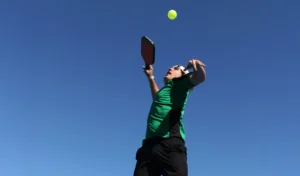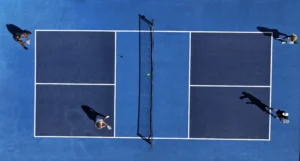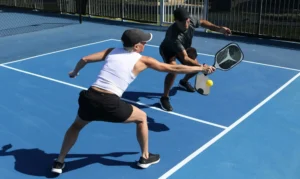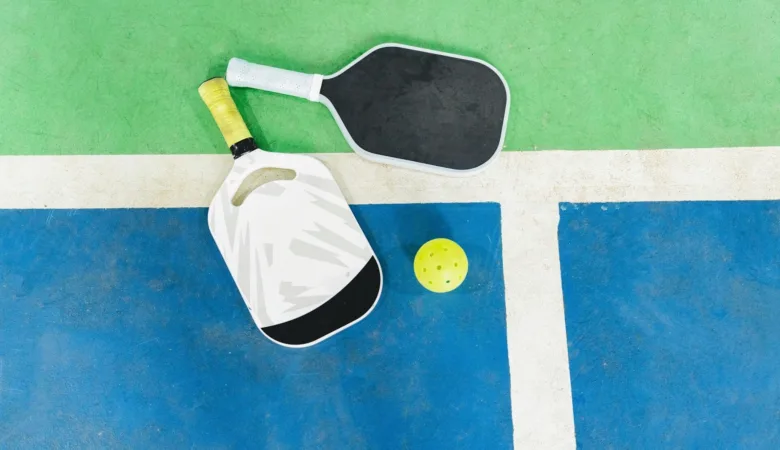
Pickleball: A fun mix of tennis, badminton, and ping pong—all rolled into one! In this beginner’s guide, we’ll review the most critical pickleball rules for beginners so you can dive in and play with confidence. Let’s get started!
The Basics of Pickleball
Pickleball is played on a court with the same dimensions as a badminton court but with a lower net than a tennis net. Players use paddles to strike a plastic ball with holes, and the game is played in singles (one on one) or doubles (two on two).
The game begins with a serve and then progresses into a rally, with each team attempting to score points by keeping the ball in play and making it difficult for the other team to return. The objective is to be the first team to score 11 points, but you must win by a two-point differential.
Pickleball Court Layout
The pickleball court has some special features:
- Court Dimensions: The court is 20 feet wide by 44 feet long.
- The Kitchen (Non-Volley Zone): A 7-foot strip on either side of the net where players can’t volley (hit the ball before it bounces).
- Service Areas: The court is split into left and right service courts, and each team must serve to the opponent’s diagonal court.
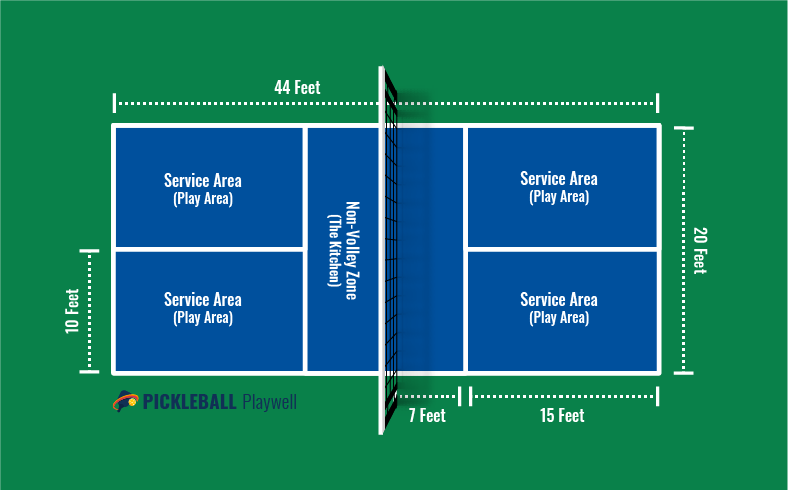
Serving Rules
The serve is a major part of pickleball rules for beginners, and there are some simple rules to remember:
- The serve must be underhand and hit below the waist.
- The server must be behind the baseline with at least one foot when serving.
- The ball must be served diagonally across the court to the opponent’s service area.
- There is a single serve attempt (except in the case of a let when the ball is hit into the net and lands in the correct service box).
Double Bounce Rule
One of the unique aspects of pickleball rules for beginners is the Double Bounce Rule. Based on this rule, the following is required:
- The receiving team must let the ball bounce before they return it.
- The serving team must let the return bounce before they can hit it.
Players can volley or let the ball bounce for a second time after two bounces. This rule ensures fair play and prevents immediate net domination.
The Kitchen Rule
The kitchen (or non-volley zone) is another defining feature of pickleball rules for beginners. Here’s how it works:
- Players cannot volley the ball (hit it in the air) while standing in the kitchen or touching the kitchen line.
- Players may enter the kitchen to return a ball that has bounced but must step out immediately after their shot.
- The kitchen rule prevents players from dominating play at the net, making the game more strategic.
Scoring in Pickleball
Scoring in pickleball follows a simple but unique format:
- Only the serving team can score points.
- Games are typically played to 11 points, and players must win by 2 points.
- In doubles, both players on the serving team have a chance to serve before the ball is passed to the other team.
Common Pickleball Faults
A fault is any rule violation that results in a loss of serve or a point for the opponent. Here are some common faults:
- Failure to Clear the Net: If the ball doesn’t clear the net during a serve or rally.
- Volleying in the Kitchen: Hitting a volley while standing in or touching the kitchen.
- Double Bounce: Failing to allow the ball to bounce once on each side before volleys are permitted.
Beginner Tips for Pickleball
- Stay Near the Kitchen Line: Once the ball has bounced, move up to the kitchen line. Most points are won at the net.
- Communicate with Your Partner: In doubles, good communication prevents confusion over who takes the shot.
- Use the Dink Shot: A dink is a soft shot that lands in your opponent’s kitchen, forcing them into a tricky position.
FAQs About Pickleball Rules
What happens if the serve lands in the kitchen?
If the serve goes into the kitchen (non-volley zone), it is a fault, and the serving side gets to lose that attempt at serving. In pickleball, the serve must be over the line of the kitchen and fall in the diagonal service box on the other side. Even if the ball just touches the kitchen line, it is a fault.
This is a regulation meant to create equitable play and deter easy drop shots off the serve. Therefore, to prolong the rally when serving, serve deep into the opponent’s service court and not in the non-volley zone.
Can I step into the kitchen to hit a ball?
Yes, you can step into the kitchen (non-volley zone), but only if the ball has bounced first. If you’re hitting a volley (striking the ball out of the air before it bounces), you cannot be inside the kitchen or even touch the kitchen line—doing so results in a fault.
However, if the ball bounces in the kitchen, you’re free to step in and hit it. Just be mindful of your positioning, as staying in the kitchen too long can leave you vulnerable to attacks from your opponent.
How does scoring work in doubles?
In doubles pickleball, each player on the serving team gets a chance to serve before the opposing team takes over, except at the start of the game. Here’s how it works:
- The game is typically played to 11 points, and you must win by at least 2 points.
- Only the serving team can score points. If the receiving team wins a rally, they don’t score but instead gain the right to serve.
- The first server (Server #1) continues serving until their team loses a rally, at which point the serve passes to their partner (Server #2).
When both players on a team lose their serve, the serve then switches to the opposing team.- The score is announced as (Server’s Score) – (Receiver’s Score) – (Server Number) (e.g., 4-2-1 means the serving team has 4 points, the receiving team has 2, and the first server is serving).
At the start of the game, only one player from the first serving team gets to serve before handing it over to the opponents—this prevents an unfair early advantage.
Can I serve overhand in pickleball?
No, all serves in pickleball must be underhand. The paddle must make contact with the ball below waist level, and the serving motion must be upward. This rule keeps the serve controlled and prevents it from becoming too powerful, making the game more accessible for all skill levels.
Additionally, the server’s arm must move in an upward arc, and the highest point of the paddle head must be below the wrist at the moment of contact. Any overhand serve or sidearm motion that doesn’t follow these guidelines is considered a fault.
So, keep it low and controlled—no tennis-style overhead smashes allowed!
Why is the Double Bounce Rule important?
The Double Bounce Rule (also called the Two-Bounce Rule) is crucial because it prevents teams from rushing the net too quickly and gaining an unfair advantage. This rule ensures that:
- Each team must let the ball bounce once on their side before volleying (hitting it out of the air).
- The receiving team must let the serve bounce before returning it, and then the serving team must also let the return bounce before playing their next shot.
This rule slows down the pace of the game, encourages longer rallies, and promotes strategy over pure aggression. Without it, stronger players could immediately charge the net and dominate every point with smashes, making the game less accessible and enjoyable for all skill levels.
By enforcing the Double Bounce Rule, pickleball stays fair, balanced, and fun—giving both teams a chance to set up their shots and play with strategy rather than just power.
Now It’s Your Turn to Play!
Getting familiar with pickleball rules is the first step to playing with confidence and having fun on the court. Whether you’re just starting out or looking to improve your game, knowing the basics will help you enjoy smoother rallies and fairer matches.
Pickleball is all about strategy, movement, and community, so don’t be afraid to jump in, make mistakes, and learn as you go. The best way to improve? Grab your paddle, find a court, and start playing! You might discover your new favorite sport.
